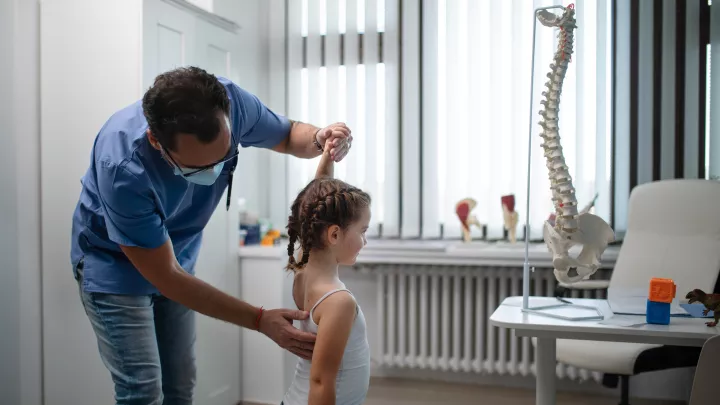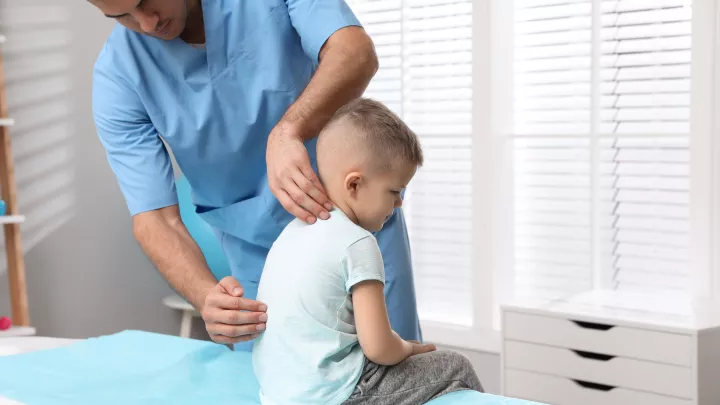
What Should Be the Lowest Instrumented Vertebra in Early Onset Scoliosis?
When treating children with adolescent idiopathic scoliosis, one of the biggest priorities for surgeons is to minimize surgery on the lumbar spine. This enables patients to maintain flexibility in their lower back, and it can decrease their risk for disc degeneration in adulthood.
But that same focus on limiting the level of the lowest instrumented vertebra (LIV) has not been applied to another group of patients: young children with early onset scoliosis. Now, new research led by Michael Heffernan, MD, a pediatric spine surgeon at the Jackie and Gene Autry Orthopedic Center at Children’s Hospital Los Angeles, is drawing attention to this issue.
This spring, Dr. Heffernan presented results from a Pediatric Spine Study Group study that found that more than 70% of ambulatory children with early onset scoliosis had an LIV of L3 or below. The paper was presented at the 30th International Meeting on Advanced Spine Techniques in Dublin, Ireland, where it was nominated for the Scoliosis Research Society’s prestigious Thomas E. Whitecloud Award.
He talks about the study’s findings—and how they are changing his own approach to LIV selection in these patients.
What prompted you to do this study?
When we treat adolescent idiopathic scoliosis, we go to extraordinary lengths to do a surgery that involves the least number of levels of the spine. Many adolescents today receive selective thoracic fusions, which end at T12 and don’t involve the lumbar spine at all.

So it’s crazy to me that we haven’t been talking about LIV selection for younger kids. This study was about raising that question. Is there something about these patients or these implants that makes it necessary to involve the lower levels of the spine? Or can we do a better job of minimizing this, as we have for adolescent patients?
What did you find?
Both larger spinal curves and smaller spinal height were associated with more caudal (lower) LIV selection. In our study, there were definitely curves that necessitated an ultimate fusion down to L3, L4 or lower.
But there were also kids who, based on their X-rays, would have received a selective thoracic fusion if they were adolescents. Instead, their growth-friendly instrumentation was inserted down to L3 or lower, which then obligates them to later have a fusion down to at least that level.
For adolescents, we generally try to end surgery at a radiographic measurement called the last substantially touched vertebra. But in our study, we found that when the last substantially touched vertebra was T12, 100% of early onset scoliosis patients still had an LIV below that level. When the last substantially touched vertebra was L2, 65% of patients had an LIV below that—meaning L3 or L4.
Why are patients with early onset scoliosis treated differently?
We suspect that it is related to the implants themselves. With both traditional growing rods and the magnetically controlled MAGEC rods, there is a connector or actuator that has to be placed in the spine. The place that connector most naturally fits is in the top part of the lumbar spine.
That said, in our study we found that the type of implant didn’t affect the LIV selection. That was surprising to me. I had thought that patients with the MAGEC rods would have a lower LIV because that actuator is a little bigger than the connector used with traditional growing rods.
What’s next for your research?
We’re trying to better understand why the younger kids are consistently receiving LIVs at L3 or L4. To do this, we are looking at kids with early onset scoliosis who came for treatment between the ages of 8 and 11. We are comparing the difference in LIV selection between patients in this group who underwent a spinal fusion as their first surgery versus those who received growing rods.
My hypothesis is that those who undergo a fusion are more likely to get a selective thoracic surgery, while those who receive growing rods ultimately end up with a lower LIV.
Have you changed your own thinking about LIV selection for these patients?
It obviously depends on the patient. There are children with early onset scoliosis and severe 140-degree curves that start right at the pelvis. By definition, they will need surgery down to low levels in the spine.
But for otherwise healthy kids who have curves more comparable to adolescent patients, I think we should be trying to bump up that LIV level as much as we can. I’m not going to start doing surgeries only to T12. But maybe instead of the LIV at L4, it can be at L3. Instead of L3, maybe it can be at L2.
Even ending a surgery one level higher can help a patient maintain better flexibility and reduce the chances of disc degeneration later on. This study was the start of that discussion, to see if we can improve how we approach these young patients.


